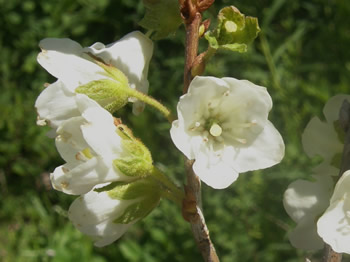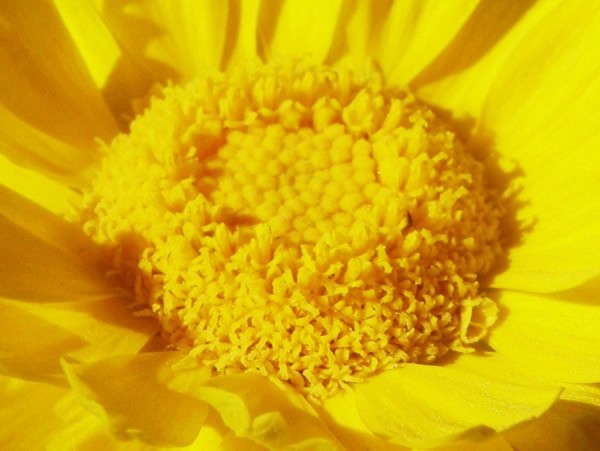|
| | |
| Parts of a Flower |
| | |
 |
If you've ever wondered what a sepal, a cluster or a floret is when
discussing flowers, we've got a few answers and explanations right here. |
| | |
|
|
One of the first things anyone notices about a flower is its petals. Flowers have varying numbers of petals and, of course, come in any astounding variety of colours.
Beneath the petals you'll notice petal-like structures called sepals (sepal = separate + petal). When the flower is just budding, the sepals enclose and protect the flower.
When the flower is in bloom, the sepals open as in this photograph of Purple Salsify, Tragopogon porrifolius. The sepals help support the petals when the flower blooms but generally they no longer have an important role. |
| |
|
__ |
|
Wood Sorrel, Oxalis albicanss, has five bright yellow petals. |
|
This Silverweed, Potentilla answeina ssp. pacifica, has six petals. |
| | |
|
|
 |
|
|
A White Rhododendron, Rhododendron albiforum, showing its petals and green sepals (calyx). |
|
This Yellow Salsify, Tragopogon dubius, has numerous petals and very visible green sepals. |
sjd| |
|
|
 |
Together the petals of a flowers are called a corolla. One of the major roles of the corolla is to attract pollinators therefore the corolla is all sorts of different colours and shapes.
Together, the sepals are called the flower's calyx (plural: calyces). |
|
|
|
__ |
|
The corolla and calyx of Common Catchfly, Silene gallica, are visible in this photograph. |
|
A Parry's Catchfly, Silene parryi, showing its corolla and calyx. |
| |
|
|
|
Some flowers have a leaf-like structures called bracts. Bracts sometimes look like petals, but they are actually specialized leaves. In Bougainvillea the bracts are very brightly coloured and help attract pollinators. The bracts surround the less colourful tiny flower. |
| |
|
__ |
|
Dwarf Dogwood, Cornus canadensis, has four white bracts which resemble petals. |
|
Indian Paintbrush, Castilleja miniata, has numerous bright red, very showy bracts. |
| |
|
|
|
One of the largest family of flowers is called Asteraceae (also called Compositae) and includes daisies, sunflowers and asters. They plants don't have petals, instead they have ray flowers which resemble petals, but in actuality are individual flowers. The ray flowers surround a structure called a disk which is made up of numerous tiny flowers called florets.
Together the ray flowers and disk make up a structure called a flower head, which is also called a capitulum (plural: capitula).
Beneath the capitulum you'll find a whorl (arrangement) of bracts called an involucre. When discussing a flower, one might refer to its involucral bracts. |
| |
|
__ |
|
Mexican Tree Sunflower, Tithonia diversifolia, is an attractive flower with numerous ray flowers which surround a large disk. |
|
Blackfoot Daisy,
Melampodium leucanthum, has beautiful white ray flowers and which surround a disk of yellow florets. |
| |
|
|
|
This photograph of the disk of a Desert Marigold, Baileya multiradiata, shows how the disk is made up of numerous tiny florets. |
| |
 |
Some corollas have unique structures. For example, Yellow Rattle, Rhinanthus minor, has numerous two-lipped corollas, since the flower resembles two lips when it's open.
In this photograph you can also see the involucre of bracts.
|
| |
|
__ |
|
Butter and Eggs, Linaria vuluaris |
|
Dalmatian Toadflax, Linaria dalmatica |
Butter and Eggs and Dalmation Toadflax are examples of plants that have two-lipped corollas. |
| |
|
|
|
Flowers usually grow on a single stem but often numerous flowers grow together in a cluster which looks like one large flower. This cluster of flowers on a stem is called an
inflorescence.
The inflorescence of the Sitka Valerian, Valeriana sitchensis, includes numerous flowers and since it resembles an upside down umbrella it is said to have an umbel shape.
Note: The flower head (capitulum) of the Asteraceae family of flowers (mentioned above) is considered to be a specialized inflorescence. |
|
The flower's inflorescence come in a variety of shapes. |
|
__ |
|
Water Smartweed, Polygonum amphibium, has a
spike-like cluster. |
|
Fennel, Foeniculum vulgar, has flowers which grow in clusters from central points. This is a branched cluster.
|
| |
|
|
|
|
|
Sea Blush, Plectritis congesta, has a head cluster. In this formation stalkless or short-stalked flowers grow in a crowded group. |
|
When the flowers are generally arranged densely along a central stalk like this Purple Loosestrife, Lythrum salicaria, is it called an elongated cluster. |
|
|
|
|
The vast majority of flowering plants have male and female parts.
The male part is called the stamen and is made up of a stalk which is called a filament and an anther which produces pollen.
The female part is called the pistil and is made up of
an ovary at the base where ovules (eggs) are produced, a style which is a tube from on top of the ovary and a stigma which receives the pollen during fertilization. |
|
|
__ |
|
This White Fawn Lily, Erythronium oregonum, has yellow anthers at the end of white filaments. The stigma is also visible and is white. |
|
The anthers of this Pink Fawn Lily, Erythronium revolutum, are yellow and stigma and style are both pink. |
| |
|
|
|
There are several other interesting structures and parts of flowers. For example, in the Pea Family of flowers (Fabaceae) there are large outer petals that together form a structure called a banner. Beneath the banner are two petals which are called wings. Beneath the wings, two other petals form a keel - which in turn encloses the reproductive parts of the plant. |
| |
|
__ |
|
American Vetch, Vicia americana |
|
Perennial Pea, Lathyrus latifolius |
American Vetch and Perennial Pea are members of the Pea Family of flowers. |
| |
|
|
|
Plants in the Araceae family of plants (called arums) like this Skunk Cabbage, Lysichiton americanus, have some interesting parts. Tiny flowers grow on a stem in a spike-like formation. The structure is called a spadix. A very large bract called a spathe almost encloses the spadix. The spathe helps attract pollinators. |
| | |
 |
We hope that this page enhances your interest in and appreciation of the wonderful world of wildflowers. |
| | |
|
|
| | |
|
|
|
Home | All Things Natural Restaurant | Bird's Nest Lounge | Cyber Room | Lagoon Trail | Naturalist's Nook | Wildflower Garden | Woodlands Pathway
Site Map | Inbox | FAQs | News and Updates | Newsletter Information | Games Room | Privacy Policy
All content © Dereila and Sage Innovations
|



























